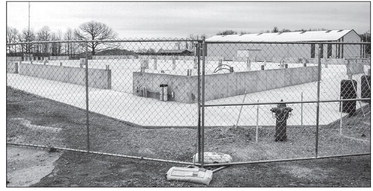Livestock barn project hit with cost overruns


Federal money may be available to offset materials inflation
The $1.9 trillion CARES Act passed by Congress earlier this month may help Clark County cover cost overruns on the new multi-purpose livestock and market sale barn it is building at the fairgrounds in Neillsville.
Even if that money proves not to be available in time, or if it doesn’t come at all, the new building is expected to be ready for the county fair on Aug. 11-15.
The concrete footings and floors of the new barn were poured already last fall, but work then stopped for the winter, with plans for construction of the structure to begin this spring. In the meantime, however, prices for materials ranging from lumber to copper and plastic conduit for electrical work shot up, putting the project at an estimated $80,000 over the level at which contractors bid on the job.
Forestry and Parks Department Administrator Curtiss Lindner said the main contractors on the job came to the county in February, asking what could be done to alleviate the overruns. Although the contractors are legally bound by the bids they submitted in 2020, Lindner said the county’s Forestry and Parks Committee understood the bind in which the material prices put them.
The committee initially agreed to cover 25 percent of the overrun with county funds. Those overruns included approximately $45,000 on the general construction bid (mainly for lumber), $18,000 for trusses, and about $17,000 for electrical materials.
Shortly after the committee agreed to cover some of the overages with county funds, the county learned of provisions of the CARES Act that allows governments to apply for grants that will cover either extra expenses they incurred due to the pandemic or losses in revenue. Because the material costs rose dramatically as plants shut down due to COVID — making supplies scarce and driving up prices — the county should be able to apply for the federal help.
“The material increases on the county’s project do qualify for this type of funding,” Lindner said.
Lindner said the Forestry and Parks Committee recently decided to submit an application for 50 percent of the cost overrun on the livestock barn. That proposal was to go to the Finance Committee for further approval this week.
The total bids for the project came in last year at $1,018,810. Those bids were accepted last May, before prices started to shoot up due to supply shortages and increased demand for building materials.
“The supply is just not there for the bidders right now,” Lindner said.
The trusses for the structure are now at the fairgrounds, and crews are waiting for arrival of main columns. Work on the project is resuming soon, with the barn expected to be ready for use by this year’s fair.
“Everybody’s very confident we’ll hit that target,” Lindner said. “It’s going to be done on time no matter what.”
Lindner said the county wanted to work with the contractors on the job, and the federal funding possibility was a timely solution.
“They’re all local contractors. They’re all living in our community,” Lindner said.
Roughly half of the barn’s total cost is being funded by donations, both monetary and in-kind. A fund-raising committee has been at work for two years organizing donations, and at this time is about $30,000 short of its $521,000 goal. It may also push for more donations to help cover part of the cost overruns.
The livestock barn project is part of a larger fairgrounds revitalization plan put together several years ago. To make room for the livestock barn, several other old buildings were razed. Those included two draft horse barns and the beef barn.
The 26,000-square foot multi-purpose barn will include a 7,400-square foot show arena, portable pens for holding livestock during the fair, and adjacent animal wash racks. The building’s location was selected in part for easing congestion with unloading/loading vehicles and to allow youths showing fair animals to house their animals in the same barn in which they will be shown, rather than having to move them between buildings.
